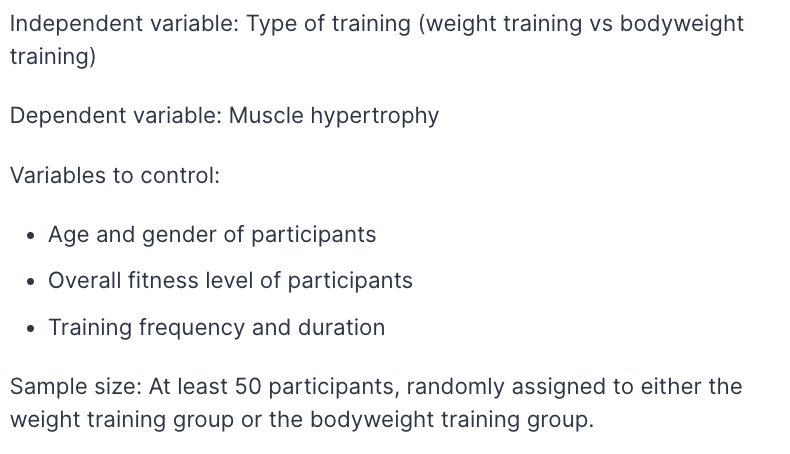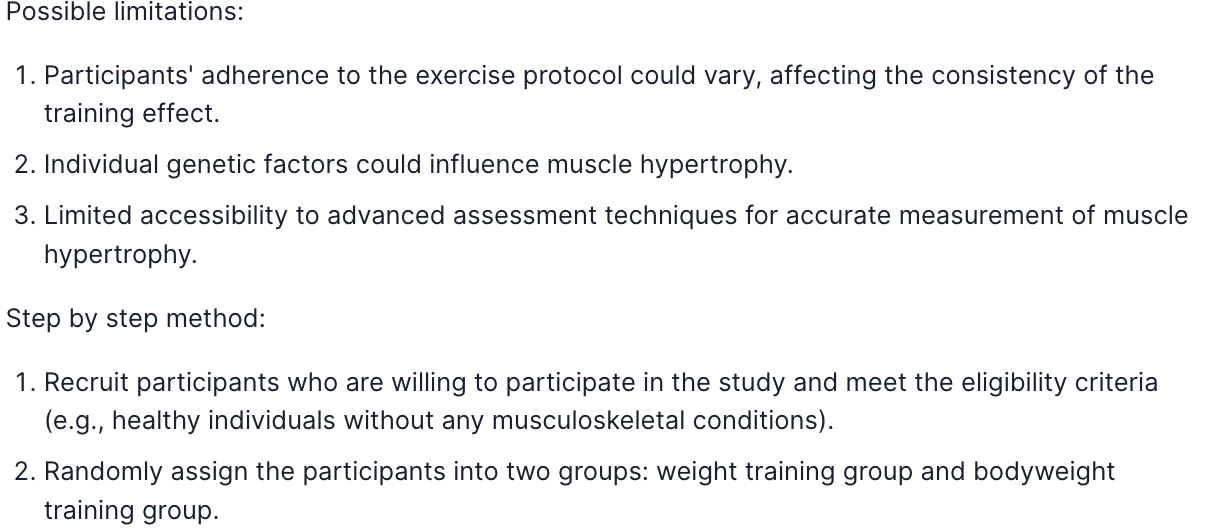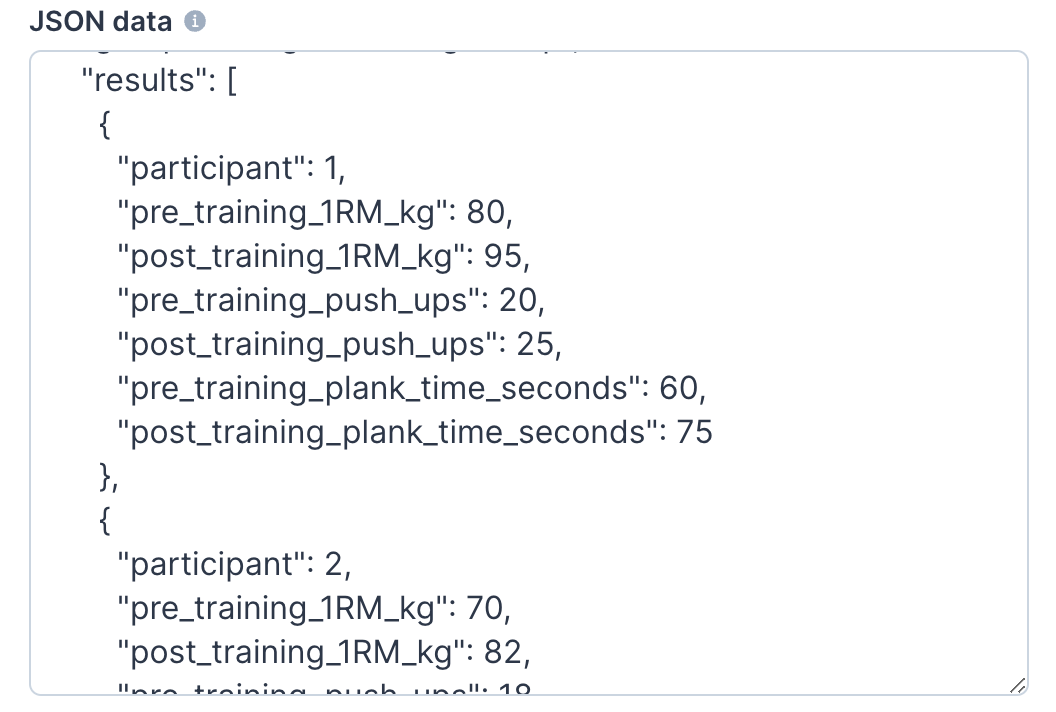Simplifying Scientific Research with AI: A Step-by-Step Guide
by Rhiaan Jhaveri on Jun 26th, 2023

Welcome to the third installment of this 10-part series on harnessing the power of Large Language Models (LLMs)! Last week, we explored the exciting realm of sentiment analysis with AI, learning how to use ChatGPT to analyze reviews of fitness products. This week, we will discover how to use AI to expedite the process of creating original research.
The usage of AI in this context does stir up debates due to LLMs' tendencies to ‘hallucinate’ non-factual information. However, our focus here is to harness AI as a research assistant, enhancing every stage of the research process rather than completely relying on it to produce content.
The research process can be broken down into literature review, experimental design, data collection, data analysis, writing, and publication. AI can be used to varying degrees at each stage. As an example, this paper will use the topic ‘bodyweight training vs weight training for muscle hypertrophy’ as a starting point for research.
Without further ado, here is a step-by-step guide on how to write your research paper using AI.
Step 1: Framing a Research Question
In the first step of your research process, AI can be an indispensable assistant for narrowing down the scope of your research. Let’s say you have the vague idea that you want to compare the effectiveness of weight training with bodyweight training. By asking ChatGPT to generate a list of hypotheses related to this topic, you might stumble upon a more focused research question. Repeat the same step with your new research question as the input and you will have even more precise and relevant options to choose from.
Step 2: Literature Review with AI
Next, we need to conduct a literature review, which involves identifying and reading existing studies relevant to your research topic. Here's how AI can help:
2.1: Identify Relevant Literature
Begin by using AI to scan various academic databases and repositories, like PubMed, Google Scholar, and others. You can ask GPT-4 to find papers related to your research topic. For instance:
"Find recent research papers discussing the impact of bodyweight and weight training on muscle hypertrophy."
This feature is available only in the beta version of GPT-4 as of June 2023.
2.2 Summarize Research Papers:
Reading through every paper can be time-consuming, but AI can help in summarizing them. Provide an abstract or a section of the paper and ask the AI to summarize. For example:
"Summarize the following abstract related to bodyweight and weight training on muscle hypertrophy."
2.3 Identify Research Gaps:
After summarizing a few research papers, ask the AI to help identify gaps in the current research that your study could fill. You might ask:
"Based on the summaries of the papers related to bodyweight and weight training on muscle hypertrophy, what research gaps exist?"
Step 2: Experimental Design with AI
Once you've reviewed the literature and identified gaps that your research could address, it's time to design your experiment. AI can assist in various ways during this process:
2.1: Formulate Hypotheses
Given the existing research summaries and identified gaps, you can ask the AI to suggest a few hypotheses for your study. For instance:
"Based on the research gaps identified, what could be potential hypotheses for the study on bodyweight training vs weight training for muscle hypertrophy?"
2.2: Suggest Experimental Design
AI can also assist in suggesting an experimental design based on the formulated hypotheses. You can specify the type of study (clinical, cross-sectional, longitudinal), number of participants, and other factors that you want the AI to specify. This pre-made prompt I created simplifies this process for you.
Simply enter your hypothesis and the type of experiment, for example:
Hypothesis used: Weight training leads to greater muscle hypertrophy compared to bodyweight training.
Type of study: Clinical
The result should look something like this:


The output contains more steps which I haven't shown here.
Step 3: Data Collection and Analysis with AI
AI can also help make data collection more efficient and accurate.
3.1 Designing Surveys or Questionnaires
If your research requires collecting data through surveys or questionnaires, AI can help in designing these. For instance, "Suggest some questions for a survey aimed at understanding individuals' experiences with bodyweight and weight training for muscle hypertrophy."
3.2 Data Cleaning
AI can help in preprocessing and cleaning the collected data. Ask the AI to highlight any potential issues or errors in your dataset that you should address before analysis.
3.3 Change Data format
Given a set of data in JSON format, you can ask ChatGPT to present the information to you in a paragraph format using this prompt.

The output:
The study compared the effects of weight training on muscle strength. The weight training group consisted of 5 participants. Before the training, the participants had an average 1RM (one-repetition maximum) of 80 kg, which increased to 95 kg after the training. The participants also showed improvements in push-ups, with an average increase from 20 to 25 repetitions, and in plank time, with an average increase from 60 to 75 seconds. Overall, the study indicates that weight training positively affects muscle strength, as demonstrated by increased 1RM, push-up repetitions, and plank...
So, by harnessing the power of AI, we can not only enhance the process of fitness research but also unlock fresh perspectives and insights, revolutionizing the way we understand and approach fitness.
To read the rest of the articles in the series, click here.